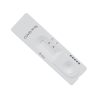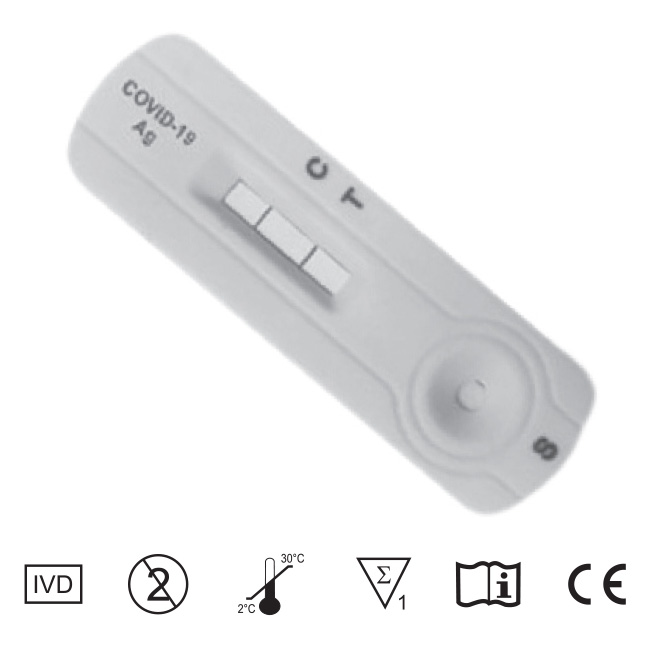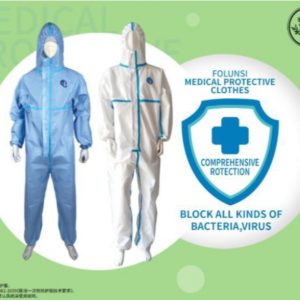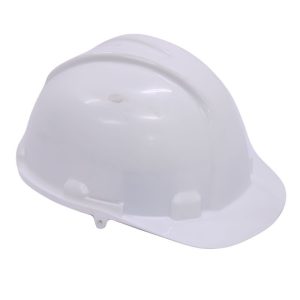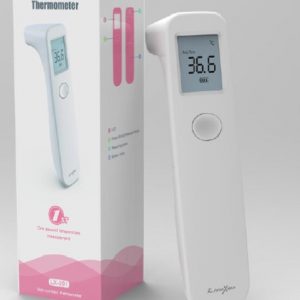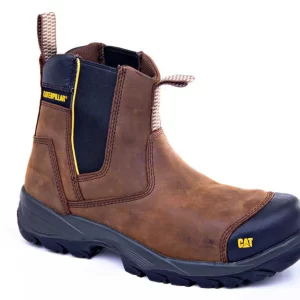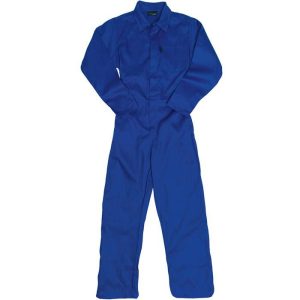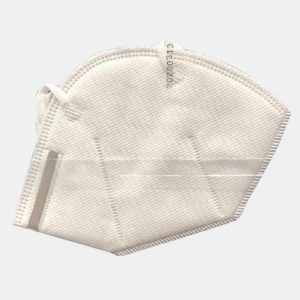Content of the box
- Test cassette
- Sterile swab
- Extraction tube with buffer and tip
- Package insert
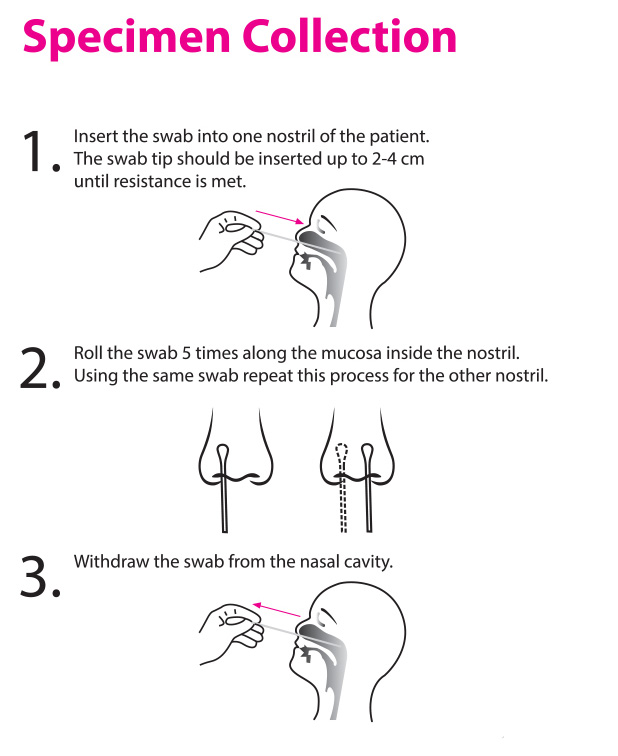
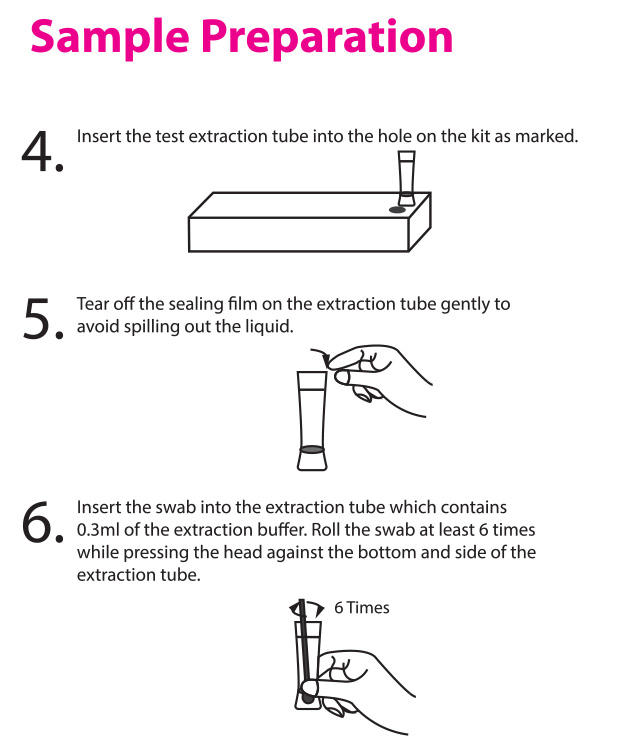
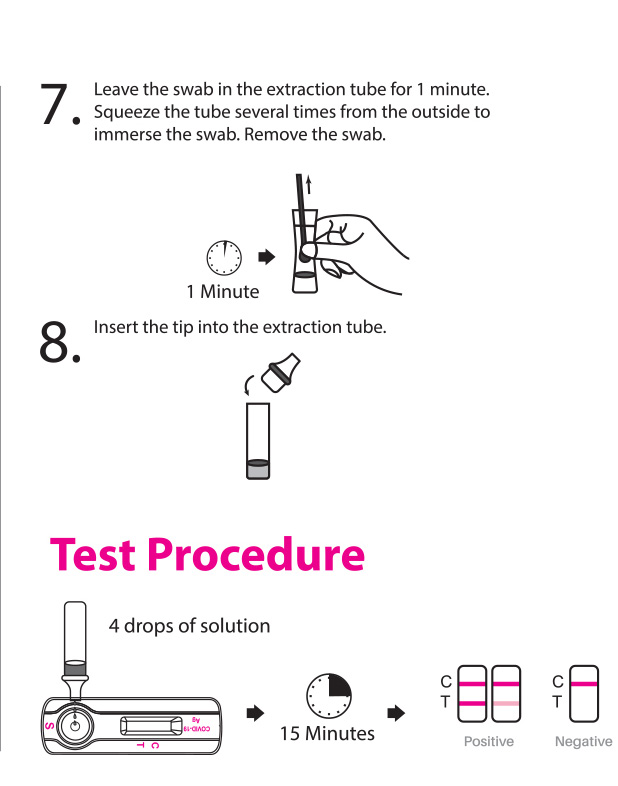
| INTENDED USE The Coronavirus Ag Rapid Test Cassette (Swab) is an in vitro immunochromatographic assay for the qualitative detection of nucleocapsid protein antigen from SARS-C oV-2 in nasopharyngeal (NP) swab specimens directly or after the swabs have been added to viral transport media from individuals who are suspected of COVID-19 by their healthcare provider. It is intended to aid in the rapid diagnosis of SARS-CoV-2 infections. The Coronavirus Ag Rapid Test Cassette (Swab) does not differentiate between SARS-CoV and SARS-CoV-2. |
| SUMMARY AND EXPLANATION The novel coronaviruses belong to the 13 genus. COVID-19 is an acute respiratory infectious disease. People are generally susceptible. Currently, the patients infected by the novel coronavirus are the main source of infection; asymptomatic infected people can also be an infectious source. Based on the current epidemiological investigation, the incubation period is 1 to 14 days, mostly 3 to 7 days. The main manifestations include fever, fatigue and dry cough. Nasal congestion, runny nose, sore throat, myalgia and diarrhea are found in a few cases. This test is for detection of SARS-CoV-2 nucleocapsid protein antigen. Antigen is generally detectable in upper respiratory specimens during the acute phase of infection. Rapid diagnosis of SARS-C oV-2 infection will help healthcare professionals to treat patients and control the disease more efficiently and effectively. |
| PRINCIPLE OF THE TEST The Coronavirus Ag Rapid Test Cassette (Swab) is an immunochromatographic membrane assay that uses highly sensitive monoclonal antibodies to detect nucleocapsid protein from SARS-CoV-2 in nasopharyngeal (NP) swab. The test strip is composed of the following parts: namely sample pad, reagent pad, reaction membrane, and absorbing pad. The reagent pad contains the colloidal-gold conjugated with the monoclonal antibodies against the nucleocapsid protein of SARS-C oV-2; the reaction membrane contains the secondary antibodies for nucleocapsid protein of SARS-CoV-2. The whole strip is fixed inside a plastic device. When the sample is added into the sample well, conjugates dried in the reagent pad are dissolved and migrate along with the sample. If SARS-CoV-2 antigen presents in the sample, a complex formed between the anti-SARS-2 conjugate and the virus will be captured by the specific anti-SARS-2 monoclonal antibodies coated on the test line region (T). Absence of the T line suggests a negative result. To serve as a procedural control, a red line will always appear in the control line region (C) indicating that proper volume of sample has been added and membrane wicking has occurred. |
| MATERIALS INCLUDED 1 Test cassettes 1 Sterile swabs 1 Extraction tubes and dropper tips 1 Buffers 1 Package insert |
| MATERIALS REQUIRED BUT NOT PROVIDED | |
| 1. | Clock, timer or stopwatch |
| WARNINGS AND PRECAUTIONS | |
| 1. | For in vitro diagnostic use only. |
| 2. | The test device should remain in the sealed pouch until use. |
| 3. | Do not use kit past its expiration date. |
| 4. | Swabs, tubes and test devices are for single use only. |
| 5. | The extraction buffer contains a solution with a preservative (0.09% sodium azide). If solution comes in contact with the skin or eyes, flush with ample volumes of waler. |
| 6. | Solutions that contain sodium azide may react explosively with lead or copper plumbing. Use large quantities of water to flush discarded solutions down a sink. |
| 7. | Do not interchange or mix components from different kit lots. |
| 8. | When collecting a nasopharyngeal swab sample, use the Nasopharyngeal Swab supplied in the kit. |
| 9. | Wear appropriate personal protection equipment and gloves when running each test and handling patient specimens. Change gloves between handling of specimens suspected of COVID-19. |
| 10. | Specimens must be processed as indicated in the SPECIMEN COLLECTION and SAMPLE PREPARATION PROCEDURE sections of this Product Insert. Failure to follow the instructions for use can result in inaccurate results. |
| 11. | To obtain accurate results, do not use visually bloody or overly viscous samples. |
| 12. | Proper laboratory safety techniques should be followed at all times when working with SARS-CoV-2 patient samples. Patient swabs, used Test Strips and used extraction buffer vials may be potentially infectious. Proper handling and disposal methods should be established by the laboratory in accordance with local regulatory requirements. |
| 13. | Humidity and temperature can adversely affect results. |
| 14. | Used testing materials should be discarded in accordance with local regulations. |
| STORAGE AND STABILITY | |
| 1. | The kit can be stored at room temperature or refrigerated (2-30°C). |
| 2. | Do not freeze any of the test kit components. |
| 3. | Do not use test device and reagents after expiration date. |
| 4. | Test devices that have been outside of the sealed pouch for more than 1 hour should be discarded. |
| SPECIMEN COLLECTION Use the nasopharyngeal swab supplied in the kit. |
|
| 1. | Carefully insert the swab into the nostril of the patient, reaching the surface of posterior nasopharynx that presents the most secretion under visual inspection. |
| 2. | Swab over the surface of the posterior nasopharynx. Rotate the swab several times. |
| 3. | Withdraw the swab from the nasal cavity. |
| SAMPLE PREPARATION PROCEDURE |
|
| 1. | lnsert the test extraction tube into the workstation in this product. Make sure that the tube is standing firm and reaches the bottom of the workstation. |
| 2. | Add 0.3 mL (about 10 drops) of the sample extraction buffer into the extraction tube. |
| 3. | lnsert the swab into the extraction tube which contains 0.3 ml of the extraction buffer. |
| 4. | Roll the swab at least 6 times while pressing the head against the bottom and side of the extraction tube. |
| 5. | Leave the swab in the extraction tube for 1 minute. |
| 6. | Squeeze the tube several limes with fingers from outside of the tube to immerse the swab. Remove the swab. The extracted solution will be used as test sample. |
| SPECIMEN TRANSPORT AND STORAGE Do not return the nasopharyngeal swab to the original paper packaging. For best performance, direct nasopharyngeal swabs should be tested as soon as possible after collection. If immediate testing is not possible, and to maintain best performance and avoid possible contamination, ii is highly recommended the nasopharyngeal swab is placed in a clean, unused plastic tube labeled with patient information, preserving sample integrity, and capped tightly at room temperature (15-30°C) for up to 1 hour prior to testing. Ensure the swab fits securely within the tube and the cap is tightly closed. If greater than 1 hour delay occurs, dispose of sample. A new sample must be collected for testing. |
|
|
TEST PROCEDURE |
|
| 1. | Remove test device from the sealed pouch just prior to the testing and lay flat on work bench. |
| 2. | lnsert a nozzle with filter into the sample extraction tube tightly. |
| 3. | Reverse the sample extraction tube, and add 4 drops (about 100 µL) of test sample by squeezing the extracted solution tube into the sample window. |
| 4. | Wait for the colored band(s) to appear. The result should be read in 15 minutes. Do not interpret the result after 20 minutes. |
| INTERPRETATION OF RESULTS |
|
| 1. | POSITIVE: The presence of two lines as control line (C) and test line (T) within the result window indicates a positive result. |
| 2. | NEGATIVE: The presence of only control line (C) within the result window indicates a negative result. |
| 3. | INVALID: If the control line (C) is not visible within the result window after performing the test, the result is considered invalid. Some causes of invalid results are because of not following the directions correctly or the test may have deteriorated beyond the expiration date. It is recommended that the specimen be re-tested using a new test. |
NOTE |
|
| 1. | The intensity of color in the test line region (T) may vary depending on the concentration of analyses present in the specimen. Therefore, any shade of color in the test line region (T) should be considered positive. Please note that this is a qualitative test only, and cannot determine the concentration of analytes in the specimen. |
| 2. | lnsufficient specimen volume, incorrect operating procedure or expired tests are the most likely reasons for control band failure. |
QUALITY CONTROL A procedural control is included in the test. A red line appearing in the control line region (C) is the internal procedural control. It confirms sufficient specimen volume and correct procedural technique. Control standards are not supplied with this test. However, it is recommended that positive and negative controls are sourced from a local competent authority and tested as a good laboratory practice, to confirm the test procedure and verify the test performance. |
|
LIMITATIONS |
|
| 1. | The etiology of respiratory infection caused by microorganisms other than SARS-CoV-2 will not be established with this test. The Coronavirus Ag Rapid Test Cassette (Swab) is capable of detecting both viable and non-viable SARS-CoV-2. The performance of the Coronavirus Ag Rapid Test Cassette (Swab) depends on antigen load and may not correlate with viral culture results performed on the same specimen. |
| 2. | Failure to follow the Test Procedure may adversely affect test performance and/or invalidate the test result. |
| 3. | lf the test result is negative and clinical symptoms persist, additional testing using other clinical methods is recommended. A negative result does not at any time rule out the presence of SARS-CoV-2 antigens in specimen, as they may be present below the minimum detection level of the test or if the sample was collected or transported improperly. |
| 4. | As with all diagnostic tests, a confirmed diagnosis should only be made by a physician after all clinical and laboratory findings have been evaluated. |
| 5. | Positive test results do not rule out co-infections with other pathogens. |
| 6. | Positive test results do not differentiate between SARS-CoV and SARS-CoV-2. |
| 7. | Negative results should be treated as presumptive and confirmed with an FDA authorized molecular assay, if necessary, for clinical management, including infection control. |
PERFORMANCE CHARACTERISTICS |
|
| 1. | Limit of Detection (Analytical Sensitivity) The limit of detection was detemined with a quantified SARS-CoV-2 virus, and the limit of detection of the Coronavirus Ag Rapid Test Cassette (Swab) is 1.15 x 102 TCID50/ml. |
| 2. | Clinical Sensitivity, Specificity and Accuracy The Coronavirus Ag Rapid Test Cassette (Swab) has been evaluated with specimens obtained from patients. A commercialized molecular assay was used as the reference method. The results show that the Coronavirus Ag Rapid Test Cassette (Swab) has a high overall relative accuracy. |
Table 1: The Coronavirus Ag Rapid Test vs PCR |
|
| Relative Sensitivity: 97.3% (71n3) Relative Specificity: 100% (130/130) Accuracy: 99.0% (201/203) |
|

